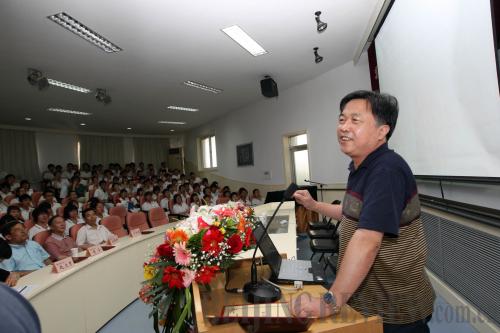|
 |
|
PUSHING GENETICS: Yang Huanming lectures students in a biology class at Beijing No.166 High School (ZHOU CHEN) |
In an experiment, scientists exchange the microorganisms of a fat mouse's intestinal tract with those of a thinner counterpart. Over a period of time they feed both the same amount of food, after which, the fat mouse turns thin while the once slim one grows fat.
The procedure is conducted by a research team headed by Yang Huanming, an academician from the Chinese Academy of Sciences (CAS) and Chairman of the Shenzhen branch of the Beijing Genomics Institute (BGI). "There are more than 170 kinds of bacteria in our bowels," Yang said. "Whether you are fat or not is to a large extent determined by your genes."
Yang's research has brought new hope for those battling the bulge. However, his research goes even further.
On April 14, 2003, scientists from China, the United States, Japan, Germany, France and Britain announced they had completed sequence mapping of the human genome, marking the end of the Human Genome Project (HGP) started in 1990. The group of Chinese experts, led by Yang, played an integral part in the research until August 26, 2001.
Although each scroll of human genome, the most complete polymorphism maps in the world, consists of 23 pairs of chromosome and about 3 billion DNA base-pairs, differences between each are common.
Genetic polymorphism refers to the difference in genes from one person to another. In fact, 99 percent of people share the same gene structure. However, it is the tiny 1-percent difference that leads to varied disease susceptibility and reactions to medicine and environment.
DNA, which carries genetic information, is often called the gene that decides one's height, skin color, disease susceptibility, etc., while the genome refers to all of an organism's genes. Human beings have only one genome, which consists of 50,000 to 100,000 genes.
"In order to unravel the mystery of life and heredity, we need to start by sequencing genes and working out their functions," Yang said.
The HGP aims to investigate genes via sequencing, locating them on the chromosome and figuring out the function of proteins produced by each, enabling humans to discover themselves at the molecular level.
However, the completed map of the human genome sequence falls short of Yang's expectations.
"Scientists generally think there is only a 0.1-percent difference in genes between any two people," Yang said. "However, we recently discovered more than 10 million gene variants, among which 8 million were previously unknown."
With the help of the gene map, doctors can now prevent and cure diseases by spotting gene variants. It also lays a foundation for combating fatal diseases such as cancer and HIV/AIDS.
"A mutant gene can be prevented from causing disease by a simple switch in lifestyle. In the meantime, medicine strives to eventually cure the effects of malfunctioning genes," Yang explained.
He said that researchers from around the world will soon finish sequencing and analysis based on the genomes of 100,000 people.
At the EuroScience Open Forum Dublin 2012 in July, Yang pointed out in his speech entitled Genomics in the Century of Biology that gene sequencing will encompass more species and move from basic research to medical application, laying a basis for future personalized medicine.
"We have discovered an anti-HIV gene in caucasians," Yang said. In fact, this is only one result of the 1,000 Genomes Project, launched on May 10, 2008, by the Shenzhen branch of the BGI, the Wellcome Trust Sanger Institute in Cambridge and the National Human Genome Research Institute in Bethesda, the United States.
Two years later, Nature magazine published a cover story celebrating the great achievements of the 1,000 Genomes Project, with Science magazine reporting on its progress in gene research technology and hailing it as a new era.
| 